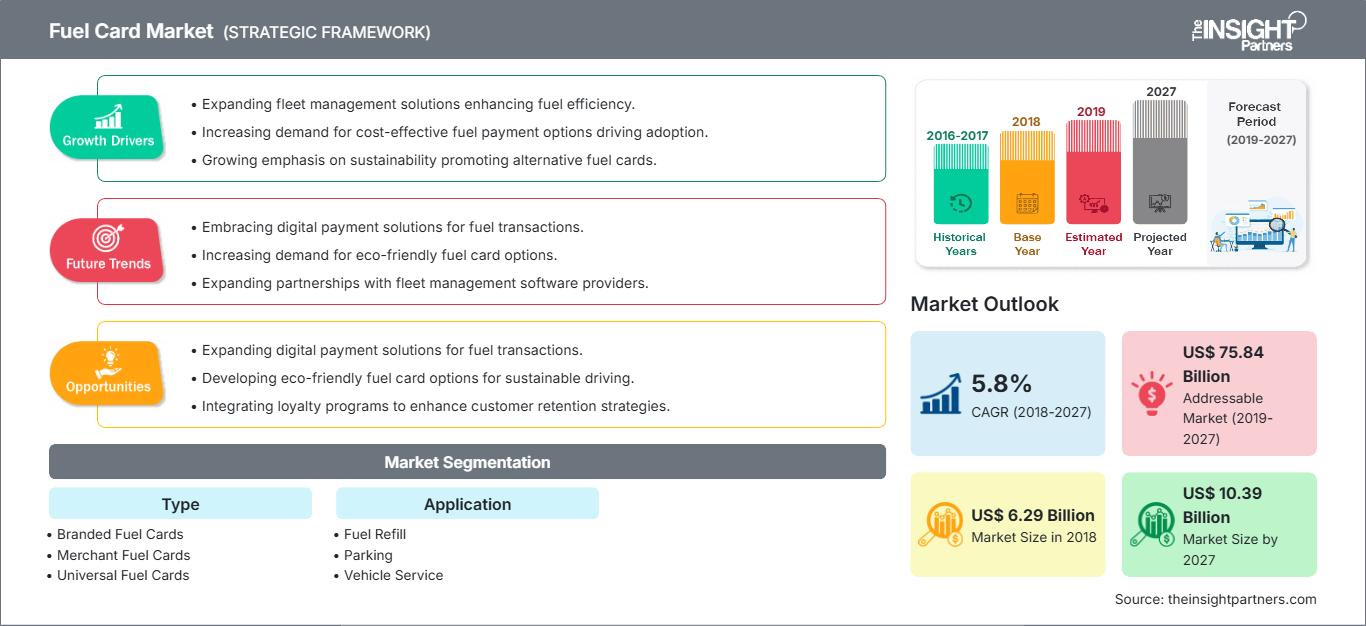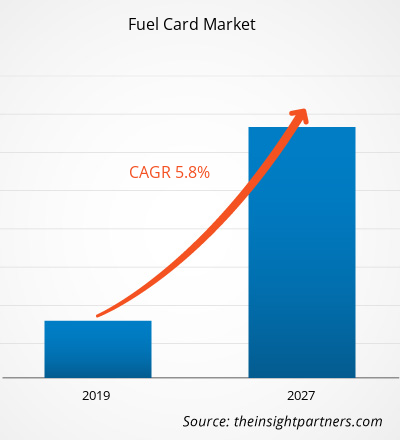[Informe de investigación] Se estima que el mercado mundial de tarjetas de combustible alcanzó los 6.290 millones de dólares estadounidenses en 2018 y se prevé que crezca a una tasa de crecimiento anual compuesta (TCAC) del 5,8% durante el período de pronóstico 2019-2027, hasta alcanzar los 10.390 millones de dólares estadounidenses en 2027.
La región de Norteamérica ostenta una importante cuota de mercado en términos de ingresos generados por tarjetas de combustible y se estima que continuará dominando el mercado durante todo el período de previsión. Las tarjetas universales son las más convenientes; sus proveedores suelen asociarse con varias compañías de combustible y ofrecen gran flexibilidad. Algunas compañías de tarjetas de combustible operan solo en ciertos países o regiones, mientras que otras solo se aceptan en determinadas gasolineras. Los usuarios con menos opciones en su región deben tener cuidado al limitarse a unas pocas gasolineras.
Perspectivas del mercado de tarjetas de combustible
Administración eficiente de flotas con la ayuda de una captura de datos mejorada
Las tarjetas de combustible permiten un seguimiento más preciso de los gastos y la eficiencia de la flota, al registrar en tiempo real el kilometraje y el consumo de combustible de cada vehículo. Los operadores de flotas utilizan estas tarjetas para cubrir gastos como mantenimiento, reparaciones, combustible, limpieza y alquiler de vehículos de reemplazo, entre otros. Los datos que registra una tarjeta de combustible incluyen la lectura del odómetro, el tipo y la cantidad de combustible, la identificación del vehículo y del conductor, información fiscal y detalles de las transacciones (hora, ubicación, importe y fecha), lo que proporciona a los gestores de flotas una gestión de recursos integral. Se prevé que este factor impulse la demanda del mercado de tarjetas de combustible durante el período de pronóstico.
Obtendrá personalización gratuita de cualquier informe, incluyendo partes de este informe, análisis a nivel de país y paquetes de datos de Excel. Además, podrá aprovechar excelentes ofertas y descuentos para empresas emergentes y universidades.
Mercado de tarjetas de combustible: Perspectivas estratégicas

-
Obtenga las principales tendencias clave del mercado que se describen en este informe.Esta muestra GRATUITA incluirá análisis de datos, que abarcarán desde tendencias de mercado hasta estimaciones y pronósticos.
Menor riesgo de fraude asociado al uso de la tarjeta de combustible
El uso de tarjetas de combustible ofrece ventajas en cuanto a funcionalidad y seguridad en comparación con otros métodos de pago, como el efectivo para gastos menores. Las tarjetas pueden personalizarse con la matrícula del vehículo o el nombre del conductor y el nombre de la empresa, lo que proporciona mayor protección contra el uso fraudulento o el uso indebido de tarjetas para repostar. La información completa sobre todas las transacciones de combustible reduce la posibilidad de un mal uso por parte de los empleados y ofrece un control superior sobre el uso legítimo de los vehículos. Por lo tanto, se prevé que el mercado de tarjetas de combustible crezca a nivel mundial.
Información sobre segmentos de tipo
El mercado de tarjetas de combustible se segmenta por componentes en tarjetas de marca, tarjetas para comercios y tarjetas universales. Las pymes y las grandes empresas suelen utilizar tarjetas de combustible para controlar su consumo y realizar pagos sin efectivo. Estas tarjetas son muy comunes en empresas y organizaciones del sector del transporte y la gestión de flotas. Las distintas compañías que operan en este sector ofrecen diferentes tipos de tarjetas. Además de repostar combustible, estas tarjetas se utilizan para otros fines. Según el emisor, las tarjetas de combustible se pueden clasificar, en términos generales, como independientes o de marca.
Información del segmento de aplicaciones
El mercado global de tarjetas de combustible, según su aplicación, se segmenta en recarga de combustible, estacionamiento, servicios para vehículos, peaje y otros. Una tarjeta de combustible permite a los usuarios y propietarios de negocios gestionar y controlar los gastos de combustible y mantenimiento. Generalmente se utilizan para pagar el combustible en gasolineras. Además, estas tarjetas también pueden usarse para pagar otros servicios para vehículos, como reparaciones, mantenimiento y asistencia en carretera. Gracias a la información detallada que ofrecen, muchas tarjetas de combustible permiten a los usuarios obtener informes en tiempo real, lo que les ayuda a estar al día de todos los gastos de su negocio y a gestionar los impuestos de sus vehículos.
Perspectivas regionales del mercado de tarjetas de combustible
Los analistas de The Insight Partners han explicado en detalle las tendencias y los factores regionales que influyen en el mercado de tarjetas de combustible durante el período de previsión. Esta sección también analiza los segmentos del mercado de tarjetas de combustible y su distribución geográfica en Norteamérica, Europa, Asia Pacífico, Oriente Medio y África, y Sudamérica y Centroamérica.
Alcance del informe de mercado de tarjetas de combustible
| Atributo del informe | Detalles |
|---|---|
| Tamaño del mercado en 2018 | 6.290 millones de dólares estadounidenses |
| Tamaño del mercado para 2027 | 10.390 millones de dólares estadounidenses |
| Tasa de crecimiento anual compuesto global (2018 - 2027) | 5,8% |
| Datos históricos | 2016-2017 |
| período de previsión | 2019-2027 |
| Segmentos cubiertos |
Por tipo
|
| Regiones y países cubiertos |
América del norte
|
| Líderes del mercado y perfiles de empresas clave |
|
Densidad de participantes en el mercado de tarjetas de combustible: comprensión de su impacto en la dinámica empresarial
El mercado de tarjetas de combustible está creciendo rápidamente, impulsado por la creciente demanda de los usuarios finales debido a factores como la evolución de las preferencias de los consumidores, los avances tecnológicos y una mayor conciencia de los beneficios del producto. A medida que aumenta la demanda, las empresas amplían su oferta, innovan para satisfacer las necesidades de los consumidores y aprovechan las nuevas tendencias, lo que impulsa aún más el crecimiento del mercado.

- Obtenga una visión general de los principales actores del mercado de tarjetas de combustible
Se observó que algunas de las iniciativas de mercado eran las estrategias más adoptadas en el mercado global de tarjetas de combustible. A continuación, se enumeran algunas de las iniciativas de mercado recientes:
2019: Edenred Capital Partners invierte en empresas innovadoras con alto potencial de crecimiento en áreas relacionadas con las actividades de Edenred. El objetivo es potenciar el ecosistema del Grupo mediante la creación de valiosas sinergias con las empresas respaldadas.
2018: Edenred, líder mundial en soluciones transaccionales para empresas, empleados y comercios, anunció hoy la firma de un acuerdo para adquirir el 80 % del capital social del grupo The Right Fuelcard Company (TRFC), el cuarto gestor de programas de tarjetas de combustible del Reino Unido.
SEGMENTACIÓN DEL MERCADO GLOBAL DE TARJETAS DE COMBUSTIBLE
Mercado global de tarjetas de combustible – Por tipo
- Tarjetas de combustible de marca
- Tarjetas de combustible de marca comercial
- Tarjetas de combustible universales
Mercado global de tarjetas de combustible – Por aplicación
- Recarga de combustible
- Aparcamiento
- Servicio de vehículos
- Cargo de peaje
- Otros
Mercado global de tarjetas de combustible – Por geografía
-
América del norte
- A NOSOTROS
- Canadá
- México
-
Europa
- Francia
- Alemania
- Italia
- Reino Unido
- España
- El resto de Europa
-
Asia Pacífico (APAC)
- Porcelana
- India
- Japón
- Australia
- Resto de Asia Pacífico
-
Oriente Medio y África (MEA)
- Arabia Saudita
- Emiratos Árabes Unidos
- Sudáfrica
- Resto de Oriente Medio y África
-
Sudamerica
- Brasil
- El resto de Sudamérica
Mercado global de tarjetas de combustible: perfiles de empresas
- BP PLC
- Corporación Exxon Mobil
- Fleetcor Technologies, Inc.
- Royal Dutch Shell plc
- Banco de EE. UU.
- Wex Inc.
- DKV
- Servicios Mundiales de Combustible
- Edenerd
- Soluciones de pago Radius.
Allstar, Arco, Caltex, Chevron Texaco, Commdel, EDC, Engen Petroleum Ltd., FastFuel, Fleetcare Pty Ltd, fuelGenie y Fuelman son algunos otros actores del mercado de la cadena de valor que no están perfilados en el informe, pero que pueden incluirse a petición.
- Análisis histórico (2 años), año base, pronóstico (7 años) con CAGR
- Análisis PEST y FODA
- Tamaño del mercado, valor/volumen: global, regional y nacional
- Industria y panorama competitivo
- Conjunto de datos de Excel
Informes recientes
Testimonios
Razón para comprar
- Toma de decisiones informada
- Comprensión de la dinámica del mercado
- Análisis competitivo
- Información sobre clientes
- Pronósticos del mercado
- Mitigación de riesgos
- Planificación estratégica
- Justificación de la inversión
- Identificación de mercados emergentes
- Mejora de las estrategias de marketing
- Impulso de la eficiencia operativa
- Alineación con las tendencias regulatorias






















 Obtenga una muestra gratuita para - Mercado de tarjetas de combustible
Obtenga una muestra gratuita para - Mercado de tarjetas de combustible